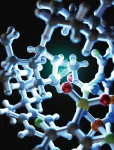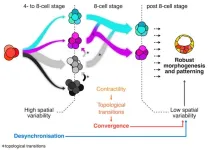(Press-News.org) An organic catalyst offers chemists precise control over a vital step in activating hydrocarbons.
Researchers at Hokkaido University in Japan have made a significant breakthrough in organic chemistry by developing a novel method to activate alkanes, which are compounds that play a crucial role in the chemical industry. The new technique, published in Science, makes it easier to convert these building blocks into valuable compounds, offering advances in the production of medicines and cutting-edge materials.
Alkanes are a primary component of fossil fuels and are also vital building blocks in the production of various chemicals and materials, such as plastics, solvents, and lubricants. But their strong carbon-carbon bonds make them quite stable and inert, presenting a challenge for chemists trying to convert them into useful compounds. To address this issue, scientists have focused on cyclopropanes, a specific type of alkane with a ring structure that makes them more reactive than other alkanes.
Many of the existing techniques for breaking down long-chain alkanes, known as cracking, tend to generate a mixture of molecules, making it challenging to isolate the desired products. This challenge arises from the reaction intermediate, a carbonium ion, which has a carbon atom bonded to five groups instead of the three typically described for a carbocation in chemistry textbooks. This makes it extremely reactive and difficult to control its selectivity.
The research team discovered that a particular class of confined chiral Brønsted acids, called imidodiphosphorimidate (IDPi), could address this problem. IDPi are very strong acids that can donate protons to activate cyclopropane and facilitate their selective fragmentation within their microenvironments. The ability to donate protons within such a confined active site allows for greater control over the reaction mechanism, improving efficiency and selectivity in producing valuable products.
“By utilizing a specific class of these acids, we established a controlled environment that allows cyclopropanes to break apart into alkenes while ensuring precise arrangements of atoms in the resulting molecules,” says Professor Benjamin List, who led the study together with Associate Professor Nobuya Tsuji of the Institute for Chemical Reaction Design and Discovery at Hokkaido University, and is affiliated with both the Max-Planck-Institut für Kohlenforschung and Hokkaido University. “This precision, known as stereoselectivity, is crucial in industries like pharmaceuticals, where the specific form of a molecule can significantly influence its function.”
The success of this method stems from the catalyst's ability to stabilize unique transient structures formed during the reaction, guiding the process toward the desired products while minimizing unwanted byproducts. To optimize their approach, the researchers systematically refined the structure of their catalyst, which improved the results.
“The modifications we made to certain parts of the catalyst enabled us to produce higher amounts of the desired products and specific forms of the molecule,” explains Associate Professor Nobuya Tsuji, the other corresponding author of this study. “By using advanced computational simulations, we were able to visualize how the acid interacts with the cyclopropane, effectively steering the reaction toward the desired outcome.”
The researchers also tested their method on a variety of compounds, demonstrating its effectiveness in converting not only a specific type of cyclopropanes but also more complex molecules into valuable products.
This innovative approach enhances the efficiency of chemical reactions as well as opens new avenues for creating valuable chemicals from common hydrocarbon sources. The ability to precisely control the arrangement of atoms in the final products could lead to the development of targeted chemicals for diverse applications, ranging from pharmaceuticals to advanced materials.
END
A holy grail found for catalytic alkane activation
2024-10-10
ELSE PRESS RELEASES FROM THIS DATE:
Galápagos finches could be singing a different song after repeated drought—one that leads to speciation
2024-10-10
Galápagos finches use their beaks to crush seeds and sing songs, so what happens to their musical trills when their beaks change to respond to new menus available under drought? Jeffrey Podos and Katie Schroeder found that the song might not remain the same after six cumulative future drought events that would likely reshape the finch beak. The projected changes in male mating songs could be so significant that they provide a pathway for ecological speciation, the researchers suggest. The researchers tested this idea by digitally modifying ...
Hidden “tails” slow marine snow, impacting deep sea carbon transfer and storage
2024-10-10
Newly discovered microscopic mucus tails – trailing from particles of marine snow particles – slow these particles’ descent into the deep ocean, research finds. This doubles the particles’ residence time in the ocean's upper layers and significantly alters estimates of how much carbon is sequestered in the deep sea. The oceans serve as a vast reservoir and critical sink for atmospheric carbon dioxide. A key process driving carbon sequestration in the ocean is the biological pump, where photosynthetic activity ...
Seed dispersal “crisis” may impact plant species’ future in Europe
2024-10-10
Europe is facing a seed dispersal “crisis,” due to extinction threats and population changes among the animals that do the seed dispersing, according to a new synthesis by Sara Beatriz Mendes and colleagues. Their literature review of animal and plant dispersal pairs helped them reconstruct the first European-wide seed dispersal network. Seed dispersal by animals is a critical part of maintaining healthy ecosystems, especially in fragmented environments like those found throughout Europe. Lack of seed dispersal to connect populations could prevent declining plant populations from ...
Nitrogen deposition has shifted European forest plant ranges westward over decades
2024-10-10
Researchers have documented a shift in plant species ranges toward the poles or higher latitudes in the face of climate warming, but Pieter Sanczuk and colleagues now reveal another unexpected pattern of range shift. For decades, understory plants in European temperate forests have been on the move westward, spurred by differences in nitrogen deposition rates. Westward species distribution shifts were 2.6 times more likely than northward ones, according to the researchers, who also noted that forest canopy changes played a role in this shift as well. The findings suggest that factors beyond climate change, such as atmospheric pollution, are also an important part of redistributing biodiversity. ...
Loss of lake ice has wide-ranging environmental and societal consequences
2024-10-10
Pasadena, CA—The world’s freshwater lakes are freezing over for shorter periods of time due to climate change. This shift has major implications for human safety, as well as water quality, biodiversity, and global nutrient cycles, according to a new review from an international team of researchers led by Carnegie Science’s Stephanie Hampton.
Undertaken by scientists based in the United States, Canada, and Sweden, this analysis represents a major call-to-action for wintertime freshwater ecology research. It is published in Science.
The world has millions of freshwater lakes, most of which freeze during the winter. The team’s rigorous review indicates ...
From chaos to structure
2024-10-10
Pipetting liquids into tiny test tubes, analyzing huge datasets, poring over research publications—all these tasks are part of being a scientist. But breaking this routine is essential. Time away from the usual work environment can spark creative ideas. Lab retreats, for instance, offer a great setting where researchers can engage with other peers, often leading to new collaborations.
The latter was true for Bernat Corominas-Murtra and Edouard Hannezo from the Institute of Science and Technology Austria (ISTA). Fascinated by a dataset showcased during a poster session at a collaborative ...
Variability in when and how cells divide promotes healthy development in embryos
2024-10-10
There is variability in when and how cells divide during the development of embryos. While researchers traditionally believed this variability was an obstacle that needed to be regulated, the Hiiragi group now found that it actually promotes healthy development. The results, published in Science on 11 October 2024, encourage other scientists to see the potential of variability and could have significant impact on assisted reproductive technology.
An embryo consists of cells. These cells divide to make new cells, allowing the embryo to grow. The cells experience variability in how and when they divide and in how they interact with each other. Scientists ...
Hidden biological processes can affect how the ocean stores carbon
2024-10-10
New Stanford-led research unveils a hidden factor that could change our understanding of how oceans mitigate climate change. The study, published Oct. 11 in Science, reveals never-before seen mucus “parachutes” produced by microscopic marine organisms that significantly slow their sinking, putting the brakes on a process crucial for removing carbon dioxide from the atmosphere. The surprising discovery implies that previous estimates of the ocean’s carbon sequestration potential may have been overestimated, but also paves the way toward improving climate models and informing ...
European forest plants are migrating westwards, nitrogen main cause
2024-10-10
New research reveals nitrogen pollution, and to a lesser extent climate change, unexpectedly as the key driver behind surprising westward shifts in the distribution of plants.
A recent study has uncovered that many European forest plant species are moving towards the west due to high nitrogen deposition levels, defying the common belief that climate change is the primary cause of species moving northward. This finding reshapes our understanding of how environmental factors, and in particular nitrogen pollution, influence biodiversity.
While it is widely assumed that rising temperatures are pushing many species toward cooler, northern areas, this research shows that westward ...
Macronutrient and micronutrient intake among US women ages 20 to 44
2024-10-10
About The Study: This cross-sectional study of pregnant and nonpregnant women of reproductive age found that vitamin A, vitamin C, and iron intake decreased over the past 2 decades, which may have substantial maternal and fetal health implications. By identifying these nutrient gaps and trends in inadequate intake in this at-risk population, scientific, health care, and regulatory communities may be better poised to adopt recommendations to improve nutrient intake.
Corresponding Author: To contact the corresponding author, Derek Miketinas, PhD, RD, email dmiketinas@twu.edu.
To access the embargoed study: Visit our For The Media website ...






